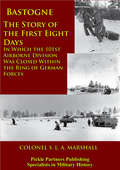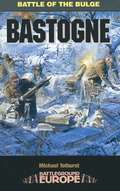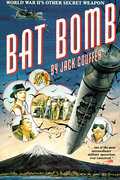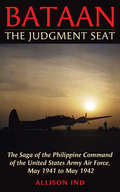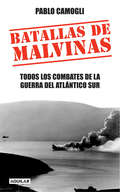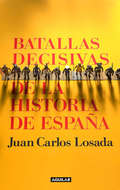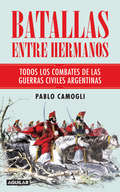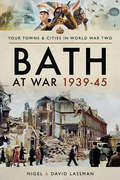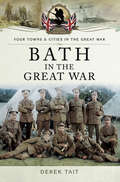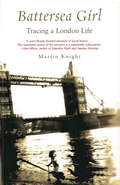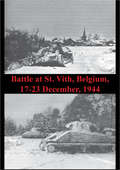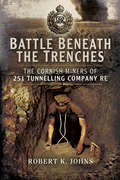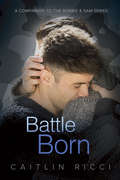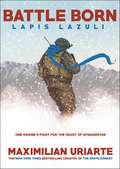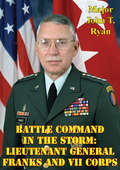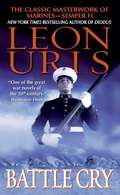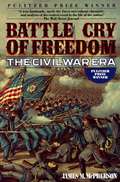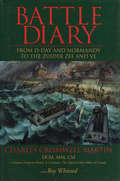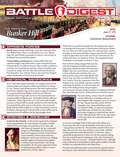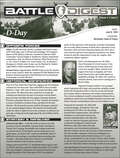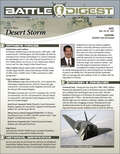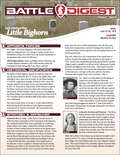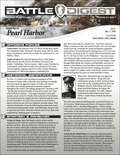- Table View
- List View
Bastogne - The Story Of The First Eight Days: In Which The 101st Airborne Division Was Closed Within The Ring Of German Forces [Illustrated Edition]
by S. L. A. Marshall[This edition benefits from numerous maps of the battlefields that the actions were fought over]"NUTS!" - Among the many military legends that abound from the fighting of the Second World War, the one word reply to a German summons to surrender must rank highly in terms of its resonance, importance and sheer grit. General Mcaulliffe decided that despite the odds and the lack of supplies and ammunition his troops would continue to hold the important communication hub of Bastogne during the Battle of the Bulge. This dramatic, yet authoritative account brings all of the action to the fore as the Battered Bastards of Bastogne wrote their names into legend."THIS STORY OF BASTOGNE was written from interviews with nearly all the commanders and staff officers and many of the men who participated in the defense of Bastogne during the first phase of that now celebrated operation--the days during which the American forces were surrounded by forces of the enemy...Thus it is essentially the account of how a single strong defensive force was built from separate commands of armor, airborne infantry and tank destroyers--a force convinced that it could not be beaten."-Introduction.
Bastogne: Battle of the Bulge (Battleground Europe)
by Michael TolhurstBy Christmas 1944, the Allies were on the threshold of victory, having remorselessly rolled the Germans back to the very borders of "The Fatherland". The, the shock of a massive Nazi counter-attack through the Ardennes in the depth of winter threw the Allies into confusion. Bastogne was at the very centre of this dramatic and most dangerous setback.
Bat Bomb: World War II's Other Secret Weapon
by Jack CoufferIt was a crazy way to win World War II in the Pacific— All the United States had to do was to attach small incendiary bombs to millions of bats and release them over Japan's major cities. As the bats went to roost, a million fires would flare up in remote crannies of the wood and paper buildings common throughout Japan. When their cities were reduced to ashes, the Japanese would surely capitulate... The plan made sense to a handful of eccentric promoters and researchers, who convinced top military brass and even President Roosevelt to back the scheme. It might have worked, except that another secret weapon—something to do with atoms—was chosen to end the war. Told here by the youngest member of the team, this is the story of the bat bomb project, or Project X-Ray, as it was officially known. In scenes worthy of a Capra or Hawks comedy, Jack Couffer recounts the unorthodox experiments carried out in the secrecy of Bandera, Texas, Carlsbad, New Mexico, and El Centro, California, in 1942-1943 by "Doc" Adams' private army. This oddball cast of characters included an eccentric inventor, a distinguished Harvard scientist, a biologist with a chip on his shoulder, a movie star, a Texas guano collector, a crusty Marine Corps colonel, a Maine lobster fisherman, an ex-mobster, and a tiger. Not to be defeated by minor logistical hurdles, the bat bomb researchers risked life and limb to explore uncharted bat caves and "recruit" thousands of bats to serve their country. Through months of personality conflicts, military snafus, and technical failures the team pressed on, certain that bats could end the war with Japan. And they might have—in their first airborne test, the bat bombers burned an entire brand-new military airfield to the ground. For everyone who relishes true tales of action and adventure, Bat Bomb is a must-read. Bat enthusiasts will also discover the beginnings of the scientific study of bats.
Bat Bomb: World War II's Other Secret Weapon
by Jack Couffer&“Inside information on a wondrously droll, highly classified yarn from WWII . . . A well-told, stranger-than-fiction tale that could make a terrific movie.&” —Kirkus Reviews The plan: attach small incendiary bombs to millions of bats and release them over Japan&’s major cities. As the bats went to roost, a million fires would flare up in remote crannies of the wood and paper buildings common throughout Japan. When their cities were reduced to ashes, the Japanese would surely capitulate . . . Told here by the youngest member of the team, this is the story of the bat bomb project, or Project X-Ray, as it was officially known. In scenes worthy of a Capra or Hawks comedy, Jack Couffer recounts the unorthodox experiments carried out in the secrecy of Bandera, Texas, Carlsbad, New Mexico, and El Centro, California, in 1942-1943 by &“Doc&” Adams&’ private army. This oddball cast of characters included an eccentric inventor, a distinguished Harvard scientist, a biologist with a chip on his shoulder, a movie star, a Texas guano collector, a crusty Marine Corps colonel, a Maine lobster fisherman, an ex-mobster, and a tiger. The bat bomb researchers risked life and limb to explore uncharted bat caves and &“recruit&” thousands of bats to serve their country, certain that they could end the war with Japan. And they might have—in their first airborne test, the bat bombers burned an entire brand-new military airfield to the ground. For everyone who relishes true tales of action and adventure, Bat Bomb is a must-read. Bat enthusiasts will also discover the beginnings of the scientific study of bats.
Bataan Uncensored
by Col. Ernest MillerBataan Uncensored, published in 1949, is the first-hand account by U.S. Army Colonel Ernest Miller of his experiences in the battle for Bataan, his subsequent surrender and participation in the infamous "Death March," followed by imprisonment at Camps O'Donnell and Cabanatuan, and finally transfer to a labor camp in Japan on a cramped, fetid "Hell Ship." Upon their arrival in the Philippines, Miller, commander of an armored National Guard unit from Minnesota—the 194th Tank Battalion—and his troops are soon thrown into the thick of the fighting in a desperate attempt to slow the Japanese take-over. The U.S. And Philippine armies, grossly unprepared for the massive Japanese invasions, do not have a chance of victory, compounded by their obsolete equipment, lack of fuel and food, and a chaotic command structure. Once in captivity, the struggle to survive begins, hindered by always inadequate food, no medicines to treat raging diseases such as malaria and dysentery, and beatings at the hands of sadistic guards. As the author states, by war's end, 75% of his battalion did not return to the United States. Unlike other works dealing with the U.S. military in the Philippines in the Second World War, Bataan Uncensored realistically portrays the experiences of the soldiers but also identifies critical weaknesses in American policy and tactics that greatly affected the outcome of the battle. Included are 11 pages of maps.
Bataan: The Judgment Seat
by Allison IndBataan: the Judgment Seat, first published in 1944 is the account of Lieutenant Colonel Allison Ind about U.S. preparations and defenses prior to and during the Japanese invasion of the Philippines. Ind, an Air Intelligence Officer, provides a blow-by-blow account of his activities within the broader picture of the war, from the tense days before the attack on Pearl Harbor, to the frantic scrambling of unprepared and under-equipped American and Filipino fighting forces, to the defense and fall of Bataan and Corregidor. The book ends with Ind leaving the Philippines via Mindanao for Australia with his commanding officer. Bataan: the Judgment Seat remains a sobering look at America's military in the Pacific during the early days of the Second World War.
Batallas de Malvinas: Todos los combates de la Guerra del Atlántico Sur
by Pablo CamogliUna obra imprescindible para que la guerra de Malvinas deje de ser una parte silenciada de nuestra historia cercana. ¿Cuál fue el significado de la guerra de Malvinas? ¿Se trató de una lucha justa contra un dominio colonial anacrónico o no fue más que la estrategia de escape de un régimen dictatorial que ya no podía ocultar su crisis? Encontrar las respuestas a estas preguntas no es tarea fácil. La necesidad de pasar de las emociones al juicio objetivo es todavía un desafío pendiente para la sociedad, que, embanderada en la causa desde una u otra posición, llena con ideología los análisis y favorece de ese modo la existencia de ese #manto de neblina# que cubre todavía los sucesos de una guerra cruda, disputada en tierras inhóspitas. Pablo Camogli se propone ayudar a descorrer ese velo mediante la exposición detallada de los hechos bélicos, porque #sin las bombas, sin la muerte, sin el hambre y el frío, ningún análisis estaría completo, ninguna conclusión sería acertada#. Tras una minuciosa investigación, enriquecida con testimonios de los protagonistas, Batallas de Malvinas cuestiona medias verdades y mitos difundidos tras la guerra para favorecer intereses políticos parciales. Revela qué pasó durante esos setenta y cuatro días, con qué capacidad militar se contó y cómo fue utilizada, cuál fue el espíritu de los soldados frente al enemigo, cómo actuaron las Fuerzas Armadas como institución y también de manera individual, sobre todo a la hora del combate, cuál fue el planteo estratégico y con qué tácticas se lo llevó a cabo.
Batallas decisivas de la historia de España
by Juan Carlos LosadaLas grandes batallas que conformaron el futuro de España. Este libro presenta una amena aproximación a los hechos bélicos que marcaron decisivamente el devenir de los acontecimientos en nuestro país. Analizar las batallas, las causas de las mismas, así como las trascendentales consecuencias de sus resultados es el objetivo de esta obra. En ella se analizan pormenorizadamente algunos episodios bélicos fundamentales, desde la Alta Edad Media hasta comienzos del siglo XIX. Juan Carlos Losada trata, por otra parte, de hacer reflexionar al lector sobre lo diferente que podría haber sido la historia de España de no haberse producido estos terribles enfrentamientos, y sobre el papel de la violencia en la construcción de los Estados.
Batallas entre hermanos: Todos los combates de las guerras civiles argentinas
by Pablo CamogliUn recorrido por más de cien años de luchas civiles en el proceso de surgimiento de la nación y la construcción del Estado argentino. «En 1813, una lucha entre dos grupos de guaraníes acabó en un enfrentamiento armado. Los protagonistas nunca lo sabrían, pero este conflicto marcó el inicio de la guerra civil en la Argentina. Sólo 101 años después, esa guerra tendría su conclusión formal.» Este libro recorre esos más de cien años de luchas fratricidas, para develar el papel central que los enfrentamientos armados tuvieron en el surgimiento de la nación y la construcción del Estado argentino. Tanto en la definición del modelo de país como en la delimitación de su territorio, esas guerras civiles no sólo acompañaron la evolución política, sino que en muchos casos la decidieron y determinaron. Con una novedosa y fundamentada interpretación, se incluye la llamada "guerra contra el indio" en el contexto de esas luchas entre hermanos. A partir de una documentada investigación, Pablo Camogli relata las batallas que jalonan esos procesos históricos. Detalla las fuerzas enfrentadas, los recursos de que disponían, los jefes que las comandaban, las tácticas aplicadas, los escenarios donde se produjeron y los resultados de más de cuatrocientos combates, en su correspondiente contexto político, social y económico. Brinda así una visión a la vez integral y pormenorizada de un aspecto central para comprender el surgimiento y la consolidación de la Argentina.
Bath at War, 1939–45 (Your Towns And Cities In World War Two Ser.)
by David Lassman Nigel LassmanBath at War 1939-45 is a comprehensive account of the citys experience of the conflict, covering in detail life on the Home Front set against the background of the wider theatres of war.The narrative of that global struggle is given with a focus on the ordeals endured by the people of Bath, as they cheered their men and women fighters off to war, welcomed thousands of evacuated men, women and children to the city, and faced the full might of Hitlers Luftwaffe.Rare insights into the life of the war-torn city are included, along with untold stories from the footnotes of history, from the Bath blitz to the influx of American GIs. The book incorporates memoirs and memories, along with in depth research from official records and newspaper accounts, so the reader sees the war from the perspective of ordinary people, although the military experiences of Baths citizens - and in many cases their tragic sacrifices - are also included.More controversial topics are also touched upon, such as civil defense, military injustice, racism and local politics, to give a full and fascinating picture of a great city facing profound trials of endurance and courage, thus revealing the many characteristics which has sustained Bath throughout its illustrious history.
Bath in the Great War (Your Towns & Cities in the Great War)
by Derek TaitWhen news of the war broke out in 1914, nothing could prepare the citizens of Bath for the changes that would envelop their city over the next four years. The story of Bath in the Great War is both an interesting and intriguing one. This book covers this historic city's involvement from the commencement of the Great War in July 1914, to the Armistice in November 1918, describing in great detail what happened to the city and its people, including their everyday lives, entertainment, spies and the internment of aliens living within the city. Bath played a key role in the deployment of troops to Northern Europe as well as supplying vital munitions. Local men responded keenly to recruitment drives and thousands of soldiers were billeted in the city before being sent off to fight the enemy overseas. The city also played a vital role caring for the many wounded soldiers who returned home from the front. As the end of the war was announced there were tremendous celebrations in the streets, but the effects of war lasted for years to come. By the end of the conflict, there wasn't a family in Bath who hadn't lost a son, father, nephew, uncle or brother. Bath features many forgotten news stories of the day and includes a considerable collection of rare photographs last seen in newspapers nearly 70 years ago.
Battersea Girl: Tracing a London Life
by Martin KnightA couple of years ago, Martin Knight began a quest to delve into his family history. He had a head start on many amateur genealogists, as 30 years earlier he had produced a school project on the very subject. The project was based on the papers and oral history of his then elderly grandmother, Ellen Tregent. Martin dusted this off and began to assemble the chain of events that shaped his grandmother's life. He even made contact with several living relatives who had known Ellen or some of the people and events she described.Ellen Tregent was born in 1888 and died in 1988 - her lifetime encompassing an unprecedented century of social change and world upheaval. She was born into a poor working-class family in Battersea, London. Her grandfather had arrived from Ireland 40 years earlier to escape almost certain death as potato famine ravaged his country. In Battersea Girl, Martin Knight charts Ellen's long and eventful life and the lives of her siblings. They encounter abject poverty, disease, suicide, murder, war and inevitably death, but, equally, the spirit of stoical people who were determined to make the most of their lives shines through in this enchanting book.
Battle At St. Vith, Belgium, 17-23 December, 1944 [Illustrated Edition]
by AnonIncludes 11 excellently detailed mapsThis is the narrative of one phase of the greatest pitched battles on the Western Front in World War II. The battle of St. Vith is an excellent example of how American Troops held their ground in the midst of confusion, defeat, and uncertainty; and thereby threw the German timetable sufficiently off schedule to allow American forces to regroup, hold, and then counterattack. The stand at St. Vith has been recognized by both German and Allied commanders as a turning point in the Battle of the Bulge.
Battle Beneath the Trenches: The Cornish Miners of 251 Tunnelling Company RE
by Robert JohnsUndermining the positions of the enemy is one of the most ancient activities. For almost 3000 years even before 1914, it was a popular siege-breaking technique. During the Great War, arguably the greatest siege the world had ever seen, it presented a conflict environment that perfectly favoured the skills of the military miner. During 1915, the Western Front was established as a static line that grew into a huge network of defence-in-depth earthworks. Siege conditions demanded siege tactics and as the ground was everywhere mineable, the Western Front was a prime candidate for underground warfare.Royal Engineer tunnelling companies were specialist units of the Corps of Royal Engineers within the British Army, formed to dig attacking tunnels under enemy lines during the First World War. The Cornish Miners were one of these specialist units recruited from the tin mines of Cornwall.In February 1915, eight Tunnelling Companies were created and operational in Flanders from March 1915. By mid-1916, the British Army had around 25,000 trained tunnellers, mostly volunteers taken from mining communities. This is their story.
Battle Born (Robbie & Sam)
by Caitlin RicciA Companion to the Robbie & Sam SeriesDaniel Messana wanted a way out of Thornwood, Colorado, and he found it in the Army. Now he’s returned with no more direction to his life than he had when he left as an angry teenager. And even though the war is behind him, the things he experienced won’t leave him in peace. His PTSD plagues him in crowds, and isolation sets in when he’s by himself. Because of the way he treated his brothers, regret gnaws at him, and he has no family to turn to. For Franklin “Coop” Cooper, the Army was life, and one he loved. But when an IED in Afghanistan left him blind, it ended not only the career he’d built, but any chance of being his own man. Back home, his parents refuse to let him do anything for himself, even though Coop and his service dog are ready to move forward and adjust to his new conditions. His only escape from being coddled like a child is going for pizza on base while his mother shops on Fridays. There, Daniel sits down next to him, and the two men begin a friendship that could become more—if they can break free from everything holding them back.
Battle Born: Lapis Lazuli
by Maximilian UriarteFrom the bestselling author of The White Donkey, a heartbreaking and visceral graphic novel set against the stark beauty of Afghanistan's mountain villages that examines prejudice and the military remnants of colonialism.In this hotly anticipatednew work from Maximilian Uriarte, creator of the popular Terminal Lance comics and The White Donkey, tells a "thrillingly cinematic" (Publishers Weekly) story of the personal cost of war and the power of human connection. Lapis Lazuli is a rich blue semiprecious gemstone found deep in the Sar-i-sang mountains of Afghanistan's Badakhshan province. For thousands of years it has sustained the nearby mining villages, whose inhabitants lived peacefully in the mountainous landscape--until the Taliban, known in the region as the Horsemen, came to seek the riches stored deep beneath the earth. Taliban rule has turned the stone into a conflict mineral, as they steal and sell it for their own gain. At the behest of the fledgling Afghan government, seeking to wrest back control of the province, United States Marines are sent into the mountains. A platoon led by their eager and naive commander, First Lieutenant Roberts, and a stoic, fierce squad leader, Sergeant King, must overcome barriers of language and culture in this remote region to win the locals' trust, and their freedom from Taliban rule. Along the way, they must also wrestle with their demons--and face unimaginably difficult choices.A sweeping yet intimate story about brutality, kindness, and the remnants of colonialism, Battle Born: Lapis Lazuli is an epic saga from the voice of a new generation of military veterans.
Battle Command In The Storm: Lieutenant General Franks And VII Corps
by Major John T. RyanThis study examines the concept of battle command from a modem historical perspective. It analyzes the decision making and leadership displayed by Lieutenant General Franks during the planning, preparation and execution of Operation Desert Storm to determine if General Franks exhibited the principles of battle command. Decision making and leadership are the two major components of battle command, a concept championed by Franks following Desert Storm, and, as such serve to frame the discussion. As the commander of the U.S. VII Corps during Operation Desert Storm, General Franks made decisions that had tactical, operational, and strategic implications. These decisions directly affected the lives and actions of the over 142,000 U.S. and British service-members assigned to his command. The results were overwhelmingly successful but many criticized him for being too cautious and conservative. This study investigates if the criticism founded in fact or whether General Franks was merely striking the best balance possible between decision making and leadership on the battlefield.
Battle Cry
by Leon UrisBattle Cry is the riveting Marine epic by the bestselling author of such classics as Trinity and Exodus. Originally published in 1953, Leon Uris's Battle Cry is the raw and exciting story of men at war from a legendary American author. This is the story of enlisted men - Marines - at the beginning of World War II. They are a rough-and-ready tangle of guys from America's cities and farms and reservations. Led by a tough veteran sergeant, these soldiers band together to emerge as part of one of the most elite fighting forces in the world. With staggering realism and detail, we follow them into intense battles - Guadalcanal and Tarawa - and through exceptional moments of camaraderie and bravery. Battle Cry does not extol the glories of war, but proves itself to be one of the greatest war stories of all time.
Battle Cry of Freedom: The Civil War Era
by James M. McphersonThe history of the Civil War that brings to life, the generals, the presidents, the soldiers, politicians, Abolitionists, Southern fire-eaters, Northern barn-burners, Copperheads, and Know-Nothings. A volume on the war and its background<P><P> Pulitzer Prize Winner
Battle Diary: From D-Day and Normandy to the Zuider Zee and VE
by Charles Cromwell Martin Roy WhitsedA fast-paced account by a soldier who was twice decorated. Charlie Martin, company sergeant-major in the Queen’s Own, was with his beloved A Company in all of the significant Normandy actions.
Battle Digest: Bunker Hill
by Christopher J. Petty<p>The Battle Digest summary includes all the key aspects of the campaign and battle, including maps, images, and lessons learned.<p> <p>In the weeks following the skirmishes at Lexington and Concord, Colonial militia and volunteers rallied around Boston to besiege Lt. Gen. Thomas Gage’s British garrison. But when reinforcements arrived from England, Gage devised a plan to regain the initiative by occupying Dorchester Heights south of town. When the Colonials heard of Gage’s plan, however, they preempted him by occupying different high ground ? the heights of Bunker Hill near Charlestown.<p> <p>When Gage awoke on 17 June to the sight of rebel positions on Breed’s Hill, he quickly attacked in what would be the first pitched battle of the American Revolution. The misnamed Battle of Bunker Hill would prove a costly and shocking victory for the British, while giving the Colonials faith in their militias and an important boost of confidence for the long struggle ahead.<p>
Battle Digest: D-Day (Battle Digest Series)
by Flint Whitlock Christopher J. Petty<p>A concise guide to the Normandy invasion with facts, maps, historical significance, strategies, and more.<p> <p>Operation Overlord, commonly referred to as “D-Day,” was the Allied invasion to secure a foothold in northern France to enable the final offensive into Germany. The Normandy invasion would be the largest combined air-sea assault landing in history. This massive feat would finally enable the Allies to deploy forces on the continent, of sufficient size and scale, to bring about the beginning of the end of Hitler and his Third Reich.<p> <p>Learn how General Eisenhower managed to attack German weakness with Allied strength as well as how intelligence and deception were crucial to the outcome.<p> <p>The Battle Digest summary includes all the key aspects of the campaign and battle, including maps, images, and lessons learned.<p>
Battle Digest: Desert Storm (Battle Digest Series)
by Christopher J. Petty<p>A concise guide to the American-led coalition’s speedy defeat of Saddam Hussein in 1991, with maps, facts, historical significance, and more. Just two years after the end of Iraq’s war with Iran, an emboldened Iraqi dictator, Saddam Hussein, invaded Kuwait. Operation Desert Storm was the final phase of the U.S.-led Coalition’s effort to expel Saddam’s forces from his southern neighbor’s borders. In less than 100 hours of joint air and ground combat, the U.S. and its allies would not only triumph, but also demonstrate to the world the superiority of a new breed of weapons. The battle also had the unintended effect of renewing a pride and confidence in the U.S. military after the long shadow of Vietnam.<p> <p>Learn how America built a coalition of nations to go to war, and how Gen. Norman Schwarzkopf used maneuver and deception to create one of the most lopsided victories in the history of warfare.<p> <p>The Battle Digest summary includes all the key aspects of the campaign and battle, including maps, images, and lessons learned.<p>
Battle Digest: Little Bighorn (Battle Digest Series)
by Michael E. Haskew Christopher J. Petty<p>A concise history of Custer’s Last Stand with maps, facts, historical significance, and more. The battle of Little Bighorn, despite its relatively small size, was the worst defeat for the U.S. Army in the Indian Wars. Although it was a clear tactical victory for the Plains Indians, it also would be a significant strategic setback for their cause. The outrage resulting from the Indian victory only intensified efforts by the U.S. Army and its Department of the Missouri to pacify the Native Americans and return those who resisted to their reservations. Within months of their victory at the Little Bighorn, the Plains Indians were defeated in the Great Sioux War of 1876–1877 and their lands in the Black Hills of the Dakota Territory were confiscated.<p> <p>Learn why the controversial George A. Custer rushed into battle against his Indian opponents on that fateful day, and how Brigadier General Terry’s failure to synchronize his forces contributed to “Custer’s Last Stand.”<p> <p>The Battle Digest summary includes all the key aspects of the campaign and battle, including maps, images, and lessons learned.<p>
Battle Digest: Pearl Harbor (Battle Digest Series)
by Michael E. Haskew Christopher J. Petty<p>A concise guide to the Japanese attack on Hawaii that plunged America into WWII, with facts, maps, historical significance, and more.<p> <p>As America prepared for WWII, everything changed on December 7, 1941—described by President Franklin D. Roosevelt as a “date which will live in infamy”—when Japan launched a successful surprise attack on the U.S. Pacific Fleet anchored at Pearl Harbor. The devastating attack crippled the fleet, while showing the world the new dominance of carrier-borne aircraft in naval warfare. Japan’s tactical success, however, belied her strategic failure. With America’s declaration of war the following day, Japan had created a determined and powerful enemy. And while Japan did gain time to expand in the Pacific, that time would be short-lived. Japan had awakened the “sleeping giant” of America.<p> <p>Learn how Admiral Yamamoto’s bold plan caught America by surprise yet doomed the larger Japanese cause. Learn also about Japan’s lost opportunities during the attack—opportunities that would have tilted the scales decidedly more in her favor.<p> <p>The Battle Digest summary includes all the key aspects of the campaign and battle, including maps, images, and lessons learned.<p>
